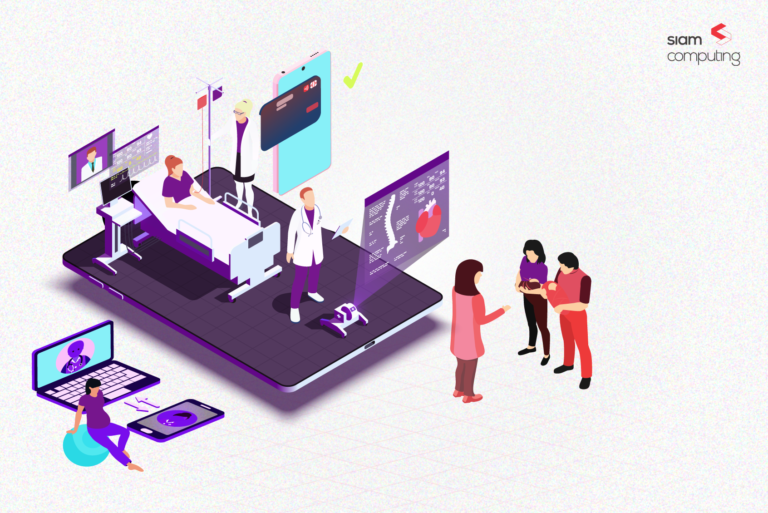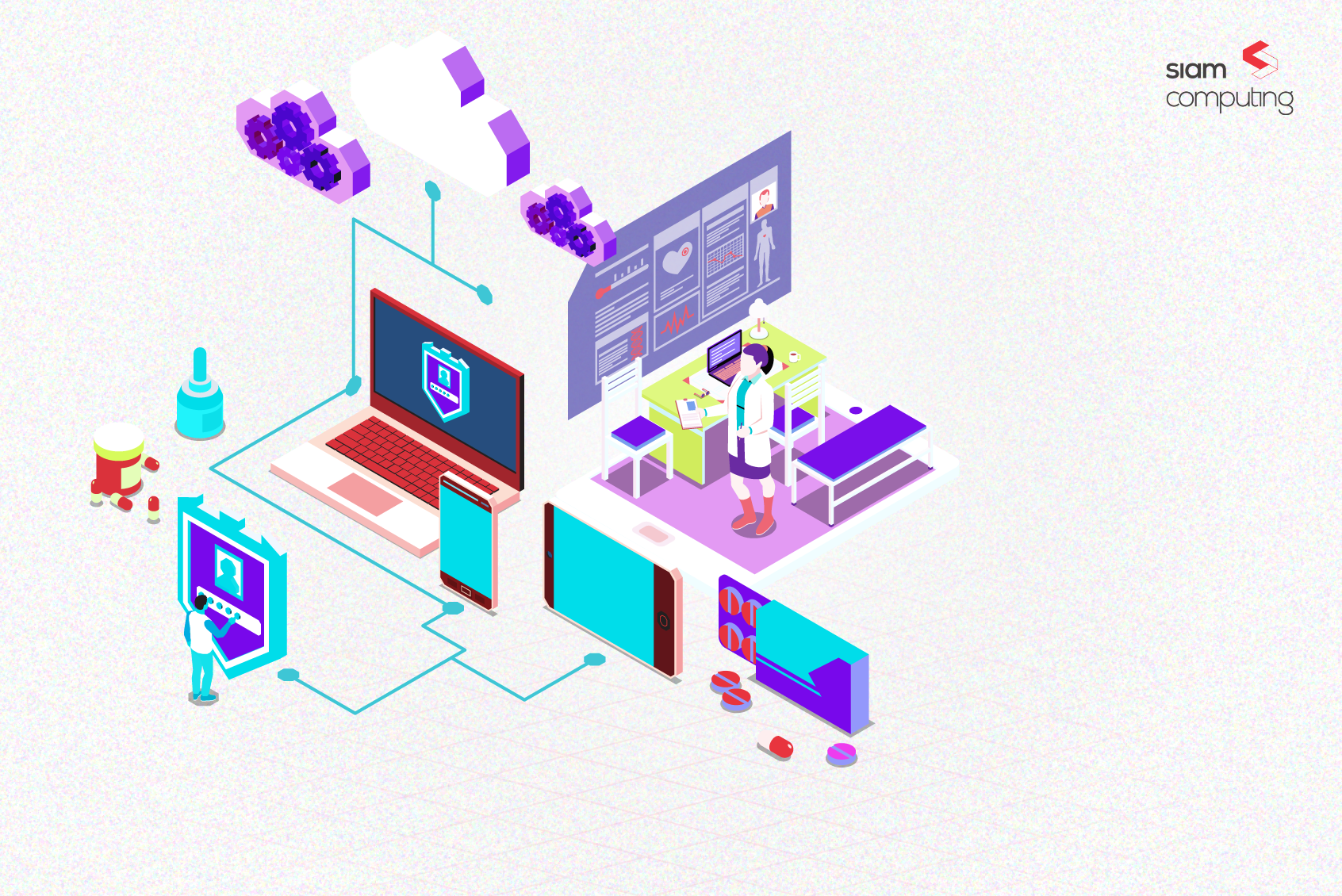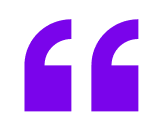Consider a patient managing a chronic condition such as diabetes in a modern-day scenario. They may utilize a continuous glucose monitor (CGM) device and use multiple apps or websites to monitor health and medication, schedule appointments, and virtually consult with doctors.
The devices and apps a patient uses on a day-to-day basis, though invaluable on their own, frequently lack seamless integration, hindering healthcare providers from accessing a holistic understanding of the patient’s health journey. The isolation of patient-centric medical devices such as CGMs and other technologies has created a fragmented landscape where crucial information often languishes in silos.
This is where the Internet of Medical Things (IoMT) comes into the picture. As a collection of medical devices and digital applications that connect to healthcare information technology systems, IoMT is set to power the new healthcare economy!
In this article, we illuminate the path forward for modern hospitals to break down these silos and foster an integrated ecosystem of wearables, monitoring tools, and digital health applications that prioritizes the patient experience.
IoMT Market Overview
The Internet of Medical Things (IoMT) has emerged as a transformative force in the healthcare industry, with its market witnessing significant growth and evolution. The IoMT Market in terms of revenue was estimated to be worth $52.33 billion in 2023.
This is indicative of the increasing recognition and adoption of IoMT solutions across the healthcare spectrum. By 2031, the market size is anticipated to reach an impressive $385.01 billion, growing at a CAGR of 28.70% from 2024 to 2031 according to InsightAce Analytic.
The IoMT market is driven by several factors, including the increasing prevalence of chronic diseases, rising healthcare costs, and the demand for more efficient and patient-centric healthcare solutions. The COVID-19 pandemic has further accelerated the adoption of IoMT, emphasizing the importance of remote monitoring and telemedicine in healthcare delivery.
Despite the promising growth, the IoMT market faces challenges that need careful consideration. Issues such as data security concerns, interoperability challenges, and the need for standardized regulations can impede the seamless integration of IoMT solutions. Overcoming these challenges requires collaborative efforts from stakeholders in the healthcare ecosystem.
Benefits and Applications of IoMT in Reshaping Patient Experience:
The integration of IoMT into patient care strategies fundamentally reshapes the way patients experience healthcare by introducing a myriad of benefits and applications, fostering a more personalized, efficient, and patient-centric healthcare ecosystem.
1. Remote Patient Monitoring (RPM)
a. Real-Time Health Tracking:
The advent of IoMT facilitates continuous monitoring of patients’ vital signs, chronic conditions, and overall health status in real-time. Wearable devices equipped with sensors capture and transmit data seamlessly to healthcare providers. This real-time data transmission enables prompt interventions and significantly reduces the need for frequent hospital visits.
For instance, patients managing chronic conditions like diabetes can benefit from CGM devices that transmit real-time glucose levels to healthcare providers, enabling timely adjustments to treatment plans and minimizing complications.
b. Chronic Disease Management:
IoMT plays a pivotal role in empowering individuals to manage chronic conditions on their own. CGMs, smart inhalers, and other connected devices provide patients with tools to actively participate in their care without the need for frequent intervention from medical professionals. This not only fosters a more proactive approach to chronic disease management but also minimizes complications, enhances the overall quality of life, and reduces the burden on healthcare resources.
2. Personalized and Proactive Healthcare:
a. Data-Driven Treatment Plans:
With the IoMT system’s ability to collect and analyze vast amounts of individual health data, healthcare professionals can craft personalized treatment plans tailored to each patient’s unique health profile. For instance, patients with cardiovascular issues may benefit from wearables and monitoring devices that continuously track key metrics.
This data-driven approach ensures that treatment decisions are not based on generalized protocols but are informed by real-time patient data, allowing for more precise and effective interventions.
b. Predictive Analytics:
Leveraging machine learning algorithms and predictive analytics, IoMT assists in identifying potential health issues before they escalate. By analyzing historical and real-time data, healthcare providers can predict and intervene in health issues at an early stage.
For instance, predictive analytics can be applied to monitor patients with chronic conditions, identifying patterns that may indicate a deterioration in health. This proactive approach not only prevents complications but also reduces the overall burden on the healthcare system by minimizing emergency interventions.
3. Enhanced Communication and Telemedicine:
a. Remote Diagnostics:
IoMT solutions facilitate remote diagnostics, revolutionizing the way healthcare professionals assess and diagnose certain conditions. The integration of diagnostic IoMT devices allows for the remote monitoring of patients, reducing the need for in-person visits. This not only accelerates the diagnostic process but also enhances the overall efficiency of healthcare delivery. For instance, a patient with a wearable ECG monitor can transmit data to healthcare providers, enabling remote monitoring of heart health and timely detection of irregularities.
B. Virtual Consultations:
With the increased adoption of remote diagnostics enabled by IoMT devices, telemedicine will become the preferred mode for doctor-patient interactions. Virtual consultations have already become increasingly accessible, breaking down geographical barriers and enhancing healthcare services, especially for individuals in remote areas or those with mobility constraints. Patients can connect with healthcare professionals in real-time, facilitating timely discussions, treatment adjustments, and medical advice.
4. Smart Hospitals and Infrastructure:
a. Streamlined Workflows:
IoMT contributes to the development of smart hospitals by optimizing workflows and automating routine tasks. Connected medical equipment, smart beds, and integrated data systems reduce administrative burdens, enabling healthcare providers to focus more on patient care.
For example, the integration of IoMT in hospital infrastructure can automate processes such as patient admission, discharge, and transfer (ADT), leading to streamlined workflows and improved operational efficiency.
b. Improved Patient Flow:
Through the integration of IoMT, hospitals can significantly improve patient flow by leveraging real-time data. IoMT enables real-time tracking of bed availability, automated scheduling, and streamlined processes. This contributes to a more seamless patient experience by reducing wait times and ensuring efficient utilization of healthcare resources. Patients experience a more organized and timely healthcare journey, from admission to discharge.
5. Treatment Tracking and Adherence
a. Smart Tracking:
IoMT solutions enhance treatment management through health and medication adherence trackers. Patients receive timely reminders, and healthcare providers can track adherence patterns, leading to better treatment outcomes.
For instance, adherence trackers can notify healthcare providers if a patient does not buy a medication refill and deviates from prescribed medication regimens. This not only improves patient adherence but also contributes to better medication outcomes.
b. Reduced Treatment Errors:
By integrating IoMT into medication management, for instance, the likelihood of errors is significantly reduced. Automated systems ensure accurate dosage administration, improving patient safety.
For example, smart medication dispensers can provide the correct dosage at the prescribed time, reducing the risk of medication errors associated with manual administration. IoMT contributes to a safer medication management process, enhancing overall patient safety and well-being.
Complexities and Challenges in IoMT Implementation:
As the Internet of Medical Things (IoMT) heralds a new era of patient-centric healthcare, it is crucial to acknowledge the complexities and challenges associated with its implementation. Navigating these hurdles is integral to ensuring a seamless integration of IoMT into the healthcare ecosystem.
1. Data Security and Privacy Concerns:
IoMT involves the continuous collection and transmission of sensitive health data. Ensuring patient confidentiality is paramount to building and maintaining trust. Robust security measures, including encryption and secure data storage, are essential to safeguard patient information.
Healthcare providers must also adhere to stringent data protection regulations, adding a layer of complexity to IoMT implementation. Compliance with standards such as HIPAA (Health Insurance Portability and Accountability Act) in the US and the Digital Information Security in Healthcare Act (DISHA) of India is non-negotiable to protect patient rights.
2. Interoperability Challenges:
IoMT faces challenges arising from many vendor-specific standards adopted by medical device manufacturers. The lack of standardized communication protocols can impede the seamless integration of diverse devices, perpetuating the existence of data silos.
Moreover, many healthcare facilities also operate with legacy systems that were not designed to accommodate the interoperability demands of IoMT. Upgrading or replacing these systems requires significant investments and strategic planning.
3. Integration with Existing Workflows:
Introducing IoMT into existing healthcare workflows can disrupt established processes. Careful planning and training are necessary to ensure a smooth transition and minimal disruption to healthcare delivery. Resistance to change can be mitigated through comprehensive training programs and clear communication about the benefits of IoMT.
4. Cost Considerations:
The implementation of IoMT involves initial investments in technology, infrastructure, and staff training. While the long-term benefits are substantial, securing the necessary resources can be a barrier for some healthcare organizations.
Demonstrating the ROI of IoMT implementation is essential for gaining organizational buy-in. The potential for improved patient outcomes, reduced hospitalization rates, and operational efficiencies contributes to the long-term financial viability of IoMT.
5. Ethical and Social Implications:
IoMT raises ethical considerations related to informed consent for continuous data monitoring. Ensuring that patients are well-informed and actively consent to data collection is vital for ethical IoMT implementation.
The adoption of IoMT may also inadvertently exacerbate health disparities if not implemented with equity in mind. The current IoMT products are not equally accessible to individuals from varied socioeconomic backgrounds. Efforts must be made in development to ensure that IoMT benefits all patient demographics, addressing potential biases in data collection and interpretation.
How Siam Computing Can Help You Enhance Patient Experience with IoMTs?
Navigating the complexities and challenges of implementing the Internet of Medical Things (IoMT) requires a strategic and experienced digital product development partner. Siam Computing emerges as a key ally in this transformative journey, offering a suite of solutions and expertise to enhance the patient experience through seamless IoMT integration.
1. Customized IoMT Solutions:
Siam Computing understands that each healthcare facility is unique, with distinct requirements and workflows. Our team specializes in developing customized IoMT solutions and implementation that align with the specific needs and goals of your organization.
We ensure the comprehensive integration of diverse IoMT devices, breaking down silos and creating a unified healthcare ecosystem. Our solutions facilitate the seamless flow of patient data, empowering healthcare providers with a holistic view of each patient’s health journey.
2. Robust Data Security Measures:
Siam Computing prioritizes a privacy-first approach, implementing robust data security measures to safeguard patient confidentiality. We can build solutions that adhere to the highest industry standards, ensuring compliance with your local healthcare regulations such as HIPAA, or DISHA. Our focus on data security builds trust among both healthcare providers and patients.
3. Interoperability Solutions:
Siam Computing specializes in overcoming interoperability challenges associated with vendor-specific standards. Our solutions ensure that diverse IoMT devices and digital solutions communicate seamlessly, fostering a collaborative and integrated healthcare environment.
We recognize the importance of existing legacy systems and offer solutions that smoothly integrate with your current infrastructure. Our expertise ensures that the transition to IoMT is conducted with minimal disruptions to ongoing healthcare operations.
4. Seamless Workflow Integration:
Siam Computing understands the importance of minimizing disruptions to existing healthcare workflows during IoMT implementation. Our solutions are designed to seamlessly integrate with your operational processes, ensuring a smooth transition to a connected healthcare environment. Our ongoing support also ensures that your team feels confident and empowered in utilizing IoMT technologies.
5. Risk-Sharing Engagement Models:
Our team works closely with you to establish a clear path toward realizing the long-term benefits of IoMT implementation. We can share the risks of implementing a new IoMT solution with a curated revenue-share payment model designed to minimize risk and maximize your healthcare facility’s growth potential. Our focus is on creating solutions that contribute to the financial viability of IoMT adoption.
Let’s Build a Connected Patient-Care Ecosystem
As we conclude our exploration into reshaping the patient experience through IoMT, it becomes evident that the integration of advanced technologies is not merely a trend but a strategic imperative for healthcare providers. From hospitals to medical instrument manufacturers, organizations across the care lifecycle can benefit immensely through the adoption of the Internet of Medical Things (IoMT).
By aligning technological innovation with the unique needs of your healthcare facility, Siam Computing empowers you to unlock the full potential of IoMT, creating a healthcare ecosystem where patient-centric devices collaborate seamlessly for enhanced care delivery.
Connect with us to explore the possibilities and shape the future of healthcare through innovative IoMT solutions tailored to your use cases. The next chapter in patient-centered care is waiting to be written, and together, we can make it a reality.







